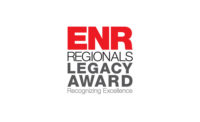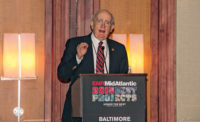When the Construction Management Association of America (CMAA) hired Bruce D’Agostino as its new president and chief executive in 1999, 17 years after its founding, it had only 700 members and was still struggling to gain exposure.
Since then, D’Agostino helped increase the McLean, Va.-based organization’s membership to more than 16,000. “Need I say more?” joked Architect of the Capitol Stephen Ayers while introducing D’Agostino as ENR MidAtlantic’s 2017 Legacy Award winner on Nov. 2 in Baltimore.
“Since I have the mic, I will,” said Ayers, immediate past chair of CMAA’s board. “Bruce worked tirelessly to develop CMAA standards of practice for construction management and program management, which [have] been adopted and in use by many federal and state governments today.”
D’Agostino, 67—who retired after Andrea Rutledge officially succeeded him in October—was CMAA’s first professional full-time employee. Ayers says D’Agostino immediately addressed negative perceptions plaguing a high-risk industry that was rife with cost overruns and time delays. He fostered relationships between CMAA and its counterparts abroad. He also formed alliances with the Construction Industry Institute and the Society of American Military Engineers (SAME), leading to the Certified Construction Manager (CCM) becoming widely recognized as one of the industry’s preferred credentials.
CCM also has helped garner “respect for construction managers on an equal basis with professional engineers and professional architects,” D’Agostino said in his Nov. 2 acceptance speech. “We are on an equal plane, with respect from all parties. With that respect, we can achieve even greater projects in the future.”
Article Index:
Learning Curve
D’Agostino’s career started in the late 1970s in public relations and marketing for the Reynolds Metals Co. at its Richmond headquarters. He pivoted to the food industry in 1982 and later became executive vice president for the International Food Industry Suppliers Association.
He was looking for another change in 1999, when a friend convinced him to interview for the CMAA position. The former English major worried CMAA would be too “right-brained” for him but says, “Once I met the folks I was really impressed with their brain power, activity and how they spoke about the projects and the uniqueness of what they did.”
Helping CMAA craft its messaging and branding was appealing to D’Agostino. He says one of CMAA’s biggest problems was that it confused industry members by pitching construction management as an alternate delivery system instead of a professional service. “They just needed somebody to tell their story,” he says. D’Agostino honed and promoted CMAA’s message that hiring accredited construction managers to run capital projects and programs is the most efficient way to complete a successful project.
“Bruce worked tirelessly to develop CMAA standards of practice for construction management and program management.”
– Stephen Ayers, Architect of the Capitol
D’Agostino had a handle on the marketing and public-relations aspects of the job, but he still needed help navigating the industry’s landscape and learning its lingo. Several pioneers of the CM movement—including John Tishman of Tishman Realty & Construction and architects George Heery and Chuck Thomsen—mentored him. Bob Wilson, the former CMAA board chairman who hired D’Agostino, took him to project sites and CMAA chapters across the country. Wilson calls D’Agostino a “quick study” and says he quickly established rapport with the chapters, “which allowed the number of chapters to increase significantly.”
D’Agostino says it took him a few years to understand the industry’s lexicon so he could confidently discuss its complexities and roles. He eventually learned contract methodology and language, too. Blake Peck, a former CMAA board member and current chief executive at multidiscipline consulting firm MBP, also worked closely with D’Agostino in those early years. Peck says D’Agostino’s outsider status was an asset because he wasn’t “encumbered by traditional industry thinking. He also proved to be a great sounding board for us subject-matter experts who might be too close to the issues or too into the weeds.”
Fever Pitch
One of D’Agostino’s first moves was to pitch CM services to school boards that were building large K-12 projects. D’Agostino says CMs are particularly well suited to serve as liaisons between school boards and all the parties involved with complicated projects. More importantly, he says, successfully building schools was a sure-fire way to earn goodwill toward CMs and CMAA. “Everybody has a school in their community,” D’Agostino notes.
D’Agostino then targeted two other public-sector markets: transportation and other infrastructure. By 2007, D’Agostino says CMAA started to gain traction with federal officials whose doubts were eased by the CCM program receiving certification from the American National Standards Institute. Large public owners such as the U.S. Army Corps of Engineers, U.S. General Services Administration and the Washington Metropolitan Area Transit Authority began putting their employees through the certification program. “That’s when people started saying ‘Jeez, if owners are going to embrace this, this is something we need to do,’” D’Agostino says.
Soon, state departments of transportation, including those in Connecticut and New York, followed suit, and CCM grew exponentially. The program recently certified its 4,000th graduate. The total number of CCMs has increased 132% in the last five years, including a one-year record of 542 new CMs added in 2017.
The CM movement has also spread beyond U.S. borders. Spain, the U.K., Korea and Japan started developing their own CM programs. “I could say we were flattered, but I would much rather have them adopt our program,” D’Agostino says.
Back to School
CMAA also has been expanding in higher education. In 2014, it helped launch a bachelor’s degree curriculum for construction management that has been recognized by the society of the Accreditation Board for Engineering and Technology (ABET) at 11 universities. A CM master’s program was accredited by ABET last year as well.
D’Agostino says the degree programs help standardize CM education so firms know what knowledge students will possess upon graduation. Moreover, he says, “Students know they will get hired if they graduate.”
Additionally, CMAA partnered with the ACE Mentor Program two years ago to help introduce high school students to CM. D’Agostino is also proud of a partnership with SAME to help certify veterans. D’Agostino, who was on SAME’s board of directors, says military service “wasn’t looked at in the same light” as commercial-sector experience. He says, “The certification program is a way of proving [veterans] had the knowledge and experience that they could do private-sector work.”
Safety Net
D’Agostino, who was inducted into the National Academy of Construction in 2015, says one of his proudest accomplishments was helping CMs take responsibility for worker safety on jobsites. When he entered the industry, he unsuccessfully pushed CMs to embrace safety, saying that CMAA members told him at the time that safety was the general contractors’ obligation. “My philosophy was everyone is responsible for safety,” he says.
D’Agostino says that CMAA members became more receptive to addressing safety awareness when key public owners joined the organization. The effort was further bolstered when CM at-risk firms joined CMAA. “It was sweet,” D’Agostino says of the transformation.
Now several months into retirement, D’Agostino says he eventually will do some consulting work and he has been asked to join a few boards. For now, he says he’s content to “do absolutely nothing.”
He’s enjoying time with his four grandchildren, all younger than four, and also looks forward to returning to the tennis court. He was sidelined in October by an Achilles tendon injury and surgery.
D’Agostino already misses the “bright and industrious” people in an industry he helped create. He’s also proud to have helped give a sense of professionalism to scores of CMs. Many have approached him to say, “‘I feel like I’m a part of something,’” D’Agostino says. “To me, that’s been the most rewarding.”







Post a comment to this article
Report Abusive Comment